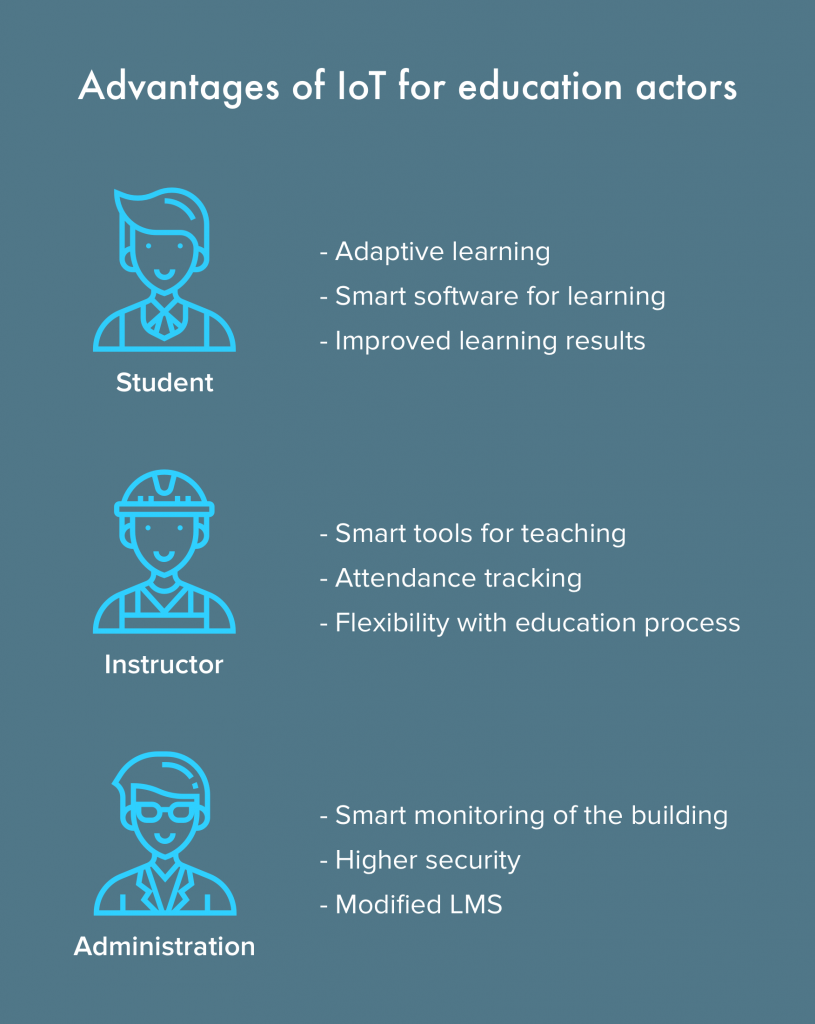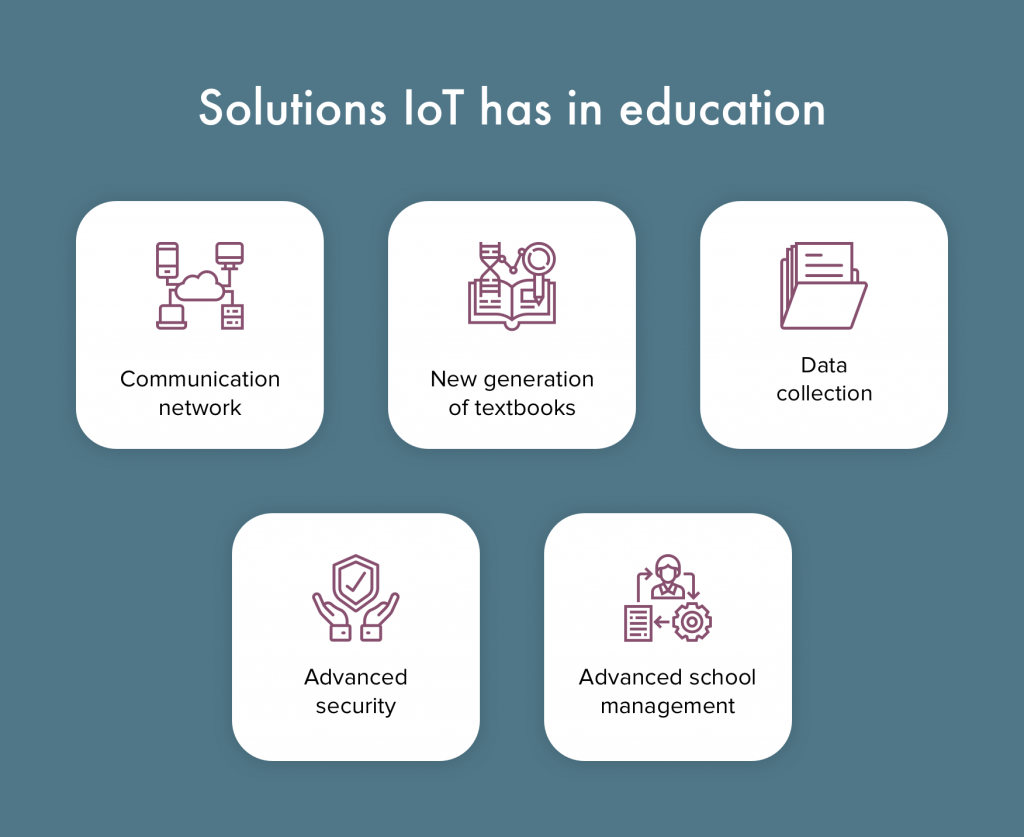Almost every public school in the US has an Internet connection. Today the Internet is much more than just web pages with information. It’s used to create a whole ecosystem of connected devices, which is called the Internet of Things. Education is one of the fields where IoT can bring significant changes.
In this post, we will discuss how IoT can be used in education and how it can engage students.
How IoT Influences Each Role in Education Process
First, let’s single out each participant in the education process to understand how IoT can influence them.

Student
Students are a primary concern in education. In fact, the whole process revolves around them. I will point out the benefits of IoT in higher education and how to make use of them.
- A personalized approach in education can adapt according to students’ needs
- Education in any part of the globe. The prevalence of gadgets and software allows students to study everywhere
- Increased students’ involvement in the educational process
- Better grades
Instructor
From college professor to school teacher — each of them is an instructor. This role can also benefit from IoT. And here’s how:
- Advanced digital tools for explaining material in a brand new way
- Automated attendance tracking
- New tools for testing students’ knowledge
- A vast field for experiments in the education process
Administration
Administration includes principles, deans, and other top-management members of educational establishments. What can IoT offer to them?
- Monitoring of HVAC system, locks, lights, and more
- Increased level of security due to sensors and smart cameras
- Improving the quality of LMS (learning management system)
This is a brief description of practical examples of IoT in education. And now, we’ll get to the detailed analysis of IoT solutions and the benefits they can bring to education.
IoT Solutions in Education
Despite centuries of development, the education field has a number of issues to be solved. And IoT offers some solutions. Let’s discover them together.
Communication Network
Instructors can communicate with students via messengers or video chats to organize the educational process. However, this approach can’t provide personal interaction that can be achieved with a physical presence in class.
With the Internet of Things, students can communicate with teachers by using connected devices like digital pens and interactive boards. Any information can be transmitted to a student’s smartphone, and it boosts the learning process. The preserved time can be spent on learning new material.
New Generation of Textbooks
Conventional students’ books became a relic of the past. It’s much more convenient to have all the books you need on your tablet. Today schools and universities provide QR codes that grant access to books. Each of those codes refers to a specific book. Thus, students have to scan the QR code to get a textbook.
Gathering Data
Every student is unique. Unfortunately, not all students are conscious. Some of them skip lessons and get low grades.
To ease the process of checking attendance, IoT offers special wristbands with RFID tags. These tags allow teachers to see how many students are in the class at the moment. Also, teachers can keep a performance record and mark the strengths and weaknesses of each student with these wristbands. However, this feature requires an establishment to build an e-learning website where all the data will be stored and processed.
Another option of tracking the attendance is beacons. They can be installed in each class and monitor the number of students in the auditory and send it to the teacher automatically.
On top of that, with the help of geofencing technology, schools and universities can develop a navigation system. Beacons, placed over the building, will guide students with the help of geolocation. Mind that this feature requires you to create a precise map of the building.
Advanced Security
Security is a top concern for any educational facility. Usually, there’s a security guard at the entrance. But this guard can’t be present in every block of the school. In this case, a biometrics system can help to keep the building safe. The facial recognition system will detect strangers and prevent intrusions. It should also be installed on campuses for students. Another option is a special ID card that helps to prevent trespassing. School buses today are equipped with GPS modules, so parents can monitor where the children are at the moment.
Advanced School Management
As was mentioned before, the school administration has to control every detail in the educational establishment. Inventory tracking may be problematic because of a large number of things to keep an eye on. RFID tags can be attached to each piece of inventory and send information about their place and condition to the server. IoT also can reduce utility bills by saving resources.

Pitfalls of IoT in Education
Despite the strong sides of IoT, it has its drawbacks as well. That’s why it’s important to highlight the difficulties that stand behind the integration of IoT.
Low Financing
It’s a pity to say that the government can’t afford to invest a lot of money in IoT projects. The advantages of IoT are definitely significant, but still not enough to attract public investments. Wearable devices and wristbands aren’t cheap at all, so only a handful of countries are ready to invest such amounts of money. However, I have faith that this problem won’t last for long. An increasing interest in the IoT sector proves that the situation will change soon.
Integration
This is a general problem of IoT. The thing is, some devices may have compatibility issues with others. Their software also can fail to cooperate with each other. Unfortunately, there’s no single standard for IoT devices, that’s why the problem remains unsolved.
Security Issue
The final problem is the lack of security standards and protocols. IoT networks can be huge and contain a lot of connected devices. Without proper security standards, hackers will easily find a vulnerability in one of the nodes. A breach will lead to failures in the functioning of the network. The worst-case scenario is when data leaks occur. However, it’s possible to solve security issues if each device will be secured properly. Each node of the network should use authentication tools and a secure firewall.

Wrapping Up
As you can see, IoT is an up-and-coming field and can bring a lot of benefits to the educational process. The tendency shows that soon there will be more solutions on the IoT market that will simplify routine processes.





